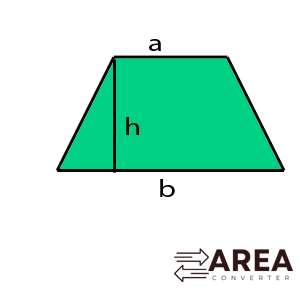Area of a Trapezoid calculator
Struggling to recall geometry formulas? This trapezoid area calculator is here to simplify things for you. With just a few quick steps, you can calculate the area of a trapezoid.

Trapezoid calculator
Definition: What is a trapezoid?
A trapezoid (known as a trapezium in British English) is a four-sided polygon, or quadrilateral, that has exactly one pair of opposite sides that are parallel. These parallel sides are referred to as the bases, while the other two sides, which are not parallel, are called the legs. The distance between the bases is known as the height, which is always perpendicular to the bases. Trapezoids are a fundamental shape in geometry and are widely studied for their properties, symmetry, and applications in mathematics and engineering.
Properties of a trapezoid
- Parallel Sides: A trapezoid has one pair of parallel sides, which are called the bases. The length of these bases can differ.
- Non-Parallel Sides: The non-parallel sides, or legs, can be equal or unequal in length. When the legs are of equal length, the trapezoid is referred to as an isosceles trapezoid.
- Angles:
- Each base forms two adjacent angles with the legs.
- The sum of the interior angles of a trapezoid is always 360°, as it is true for all quadrilaterals.
- In an isosceles trapezoid, the angles adjacent to each base are equal, creating additional symmetry.
- Height: The perpendicular distance between the two bases is the trapezoid's height, critical for calculating its area.
Types of trapezoids
- Isosceles Trapezoid: The legs are of equal length, and the base angles are congruent. Additionally, the diagonals are of equal length.
- Right Trapezoid: One of the legs is perpendicular to the bases, forming two right angles.
- Scalene Trapezoid: Neither the legs are equal, nor are the base angles congruent.
Applications
Trapezoids are used in architecture, engineering, and geometry for measuring irregular areas, designing structures, and solving real-world problems. Their unique mix of parallelism and asymmetry makes them versatile shapes with rich geometric properties.
How to calculate the area of a trapezoid?
The area of a trapezoid can be calculated using several methods depending on the given parameters. Below are all possibilities:
Using the bases and height
This is the most common formula to calculate the area of a trapezoid. It requires the lengths of the two parallel sides (bases) and the perpendicular distance (height) between them.
Example: If a = 8 m, b = 5 m, h = 4 m:
Using the midsegment and height
The midsegment of a trapezoid is the segment joining the midpoints of the two non-parallel sides. The area can also be calculated by multiplying the midsegment length by the height.
Example: If a = 8 cm, b = 4 cm, h = 6 cm:
A = 6 × 6 = 36 cm²
Using trigonometry (when height is unknown)
If the height is not given, but the length of one leg and the angle between the base and the leg are known, the height can be determined using trigonometry.
Example: If a = 7 m, b = 5 m, c = 4 m, θ = 60°:
A = ((7 + 5) × 3.464) / 2 = (12 × 3.464) / 2 = 20.784 m²
